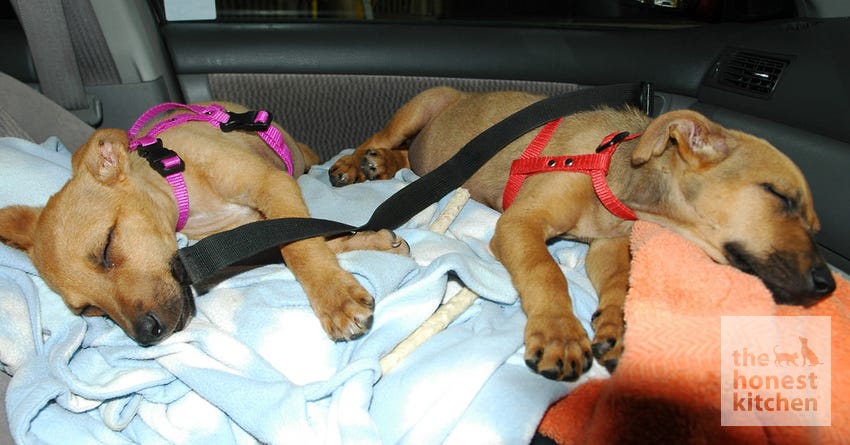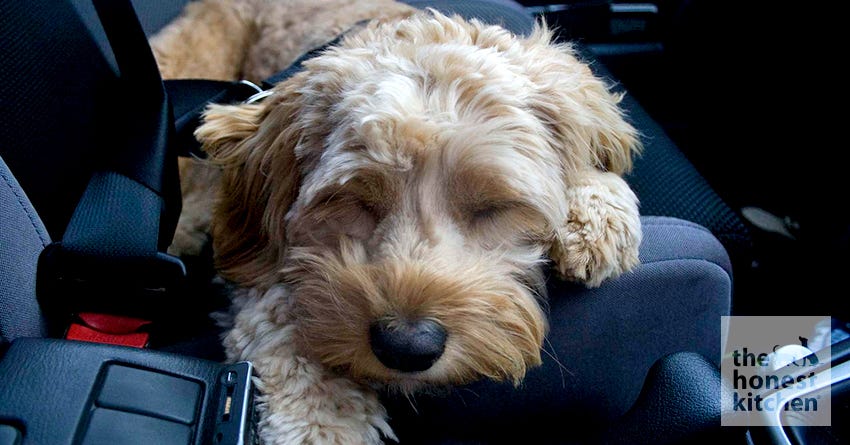Having a dog that experiences car sickness is stressful for both the pup and the owner. No one enjoys seeing their pet in discomfort, and the thought of causing your dog any level of pain can reroute entire vacation plans.
That’s why we put together this helpful dog car sickness guide. Follow along to make your dog as comfortable as possible the next time the two of your need to hit the road.
Why Do Dogs Get Car Sick?
Any age dog, but particularly puppies and older dogs are prone to car sickness.

Balance and Ear Development
Puppies often get car sick because their ears are still developing and the motion of the car can upset those delicate structures.
High Anxiety
More mature dogs might experience car sickness due to their natural levels of anxiety.
Due To a Previous Traumatic Experience In a Car
Other dogs might develop carsickness as a result of a traumatic experience, like being involved in a car accident, that automatically triggers their discomfort.
Car Sickness Became A Habit
Once a dog or puppy has suffered from car sickness a couple of times, they might become so stressed about getting in the car that they’ll work themselves up in anticipation of getting sick; so much so they will make themselves sick. In other words, car sickness becomes a habit even after their ears have matured and they have no other reason for it.
For these puppies (or dogs) home remedies rarely work to calm the anxiety, so talk to your veterinarian about medication that could be used while you reintroduce your puppy to the car. Although some puppy owners would prefer to skip medications, these usually help the puppy conquer his fear (or change his mind) about the car more quickly than he would without it.
Common Signs and Symptoms
- Drooling Excessively
- Panting From Anxiety
- Pacing and Moving Around A Lot
- Whining
- Excessive swallowing
- Wide-eyes
- Sometimes Vomiting
Tips For Helping Your Dog With Car Sickness
Try the following tips and prevention methods to provide your carsick dog with the most comfortable car-ride experience.
1) Consult your vet
Before you hit the road, take your dog in for a quick consult at the vet. Tell your vet about previous incidents of car sickness; she may be able to recommend an easy solution.
Some Common Car Sickness Medications For Dogs
- Cerenia
- Meclizine
- Dimenhydrinate
- Diphenhydramine
- CBD
2) Secure your dog with a harness or seatbelt designed for them
There is a range of harnesses, car seats, and seat belts designed to keep your pup safe and secure on the road. Find what fits your dog best, and use it consistently. Be sure your dog is accustomed to the apparatus you select prior to hitting the road for your trip. Use it for short jaunts around town so that anxiety about a new harness doesn’t add to any road-trip anxiety.
3) Block your dog’s view of the road and cars
Oftentimes, car sickness is triggered by motion, which is why it’s also called motion sickness. Affix a sunscreen, available just about everywhere, to the window closest to your dog’s seat belt to obscure his vision of passing cars.
4) Try Over-The-Counter Treats and Sprays
All-natural calming sprays and calming treats may help alleviate car sickness. Chewables, liquids, gel tablets, and more are available, and not all are effective for all dogs. Try several options with drives around town before your big trip to gauge effectiveness for your dog.
5) Try a Re-Introduction Program For Your Dog
When re-introducing the car, it’s important to take your time. Don’t skip steps and don’t rush the process. Your dog needs to be comfortable at each step before going on to the next.
Step 1: Before starting this re-introduction program, give your dog or puppy a break from the car for at least a week. Take him for walks but don’t drive him anywhere.
Step 2: Begin offering him special treats in the car with the door wide open. Just sit next to him with the engine turned off. Give him a treat and praise him. If he’s anxious, stop right there and repeat this again later. If he looks like he’s having fun, do it two or three times then stop.
Step 3: After three or four days of this, then offer him his meals in the car. Again, make sure the door is open, the engine is off, and you remain sitting with him. When he’s dashing eagerly to the car anticipating his meals, then offer them in the car, and while he’s eating turn the engine on. When he’s fine with this, then you’re ready to continue on to the next step. Now when he dashes to the car, let him get in, and drive down the block and back, then feed him his meal.
Step 4: After a day or two of this, if he’s still calm, you can begin making short drives around the block, down the street, and to the park for a walk. Make sure each car ride results in something good; either a meal, treats, a walk, or a play session. Gradually increase the time and distance of each ride.
6) Play specially-composed music
Music like Through a Dog’s Ear has been designed to calm anxiety in dogs. It’s been clinically tested and proven to work even in shelter environments. CDs are available, as is a portable player called the iCalmDog, which is pre-loaded with four hours of canine-calming music. Bonus: This is a great way to soothe nervous pups in a hotel room, too.
7) Give Your Dog Something to Chew On
This may be a time for a favorite edible chew like The Honest Kitchen’s beams. You want something that your dog can consume safely and something that is also very appetizing to him. Avoid new chews so that you know exactly how your dog consumes them in order to help avoid choking hazards (if you have any doubt, don’t use a chew). The key is for him to be so completely engaged in gnawing on his chew that he’s not anxiously pacing across the backseat. If you don’t have doggie seat covers for your car, make sure to bring a towel where he can do his chewing or you may end up with quite a mess on your seats.
8) Ginger to Soothe the Stomach
Ginger is a great anti-nausea remedy. If you know your dog suffers from car sickness and is in good health, consider giving your pet a little ginger before getting in the car. Avoid ginger if your pet is pregnant or lactating, has a bleeding disorder or heart condition, has a fever, is undergoing any treatment, is on any medications, and/or if he will be having surgery. Consult your vet for any questions.
How To Introduce A Puppy To The Car To Avoid Car Sickness
When re-introducing the car, it’s important to take your time. Don’t skip steps and don’t rush the process. Your puppy needs to be comfortable at one step before going on to the next.
Unfortunately, this can be traumatic since you’re taking him away from his mother and littermates as well as his first human family. Although you may already be in love with this fuzzy little creature, he could be frightened. This fright can lead to a fear of cars, riding in the car, and ultimately car sickness. That’s not the best way to begin his new life. Thankfully, though, you can help your puppy.
Ask The Breeder To Feed Your Pup A Small Meal
When you go pick up your new puppy, ask the breeder or foster to give the puppy a small meal ahead of time. A full meal could lead to an upset stomach so a small meal (maybe one-quarter of the normal meal) can tide your puppy over until you get home.
Use A Secure Crate In the Backseat
For his safety, the puppy should ride in a crate. Although most new puppy owners prefer to hold the puppy in their arms, it’s not safe. Not only can the puppy be endangered in sudden stops or in an accident, the puppy is more likely to be frightened at the scenery zipping by, and watching all these things could also lead to an upset tummy. Plus, should he panic and wiggle out of your arms, he could hurt himself or interfere with the driver. You can snuggle him later, but for his sake, on the ride home put him in a crate.
Place the crate in the back seat where it can be secured with a seat belt or tie-down so it will ride without too much jostling. If possible, have the crate opening facing so an air vent will blow across the front. You don’t want the air conditioning to blow there on full/cold but the puppy will do better with some airflow.
Drive Your Puppy Straight Home
Once you have your puppy, drive straight home. Don’t go visit anyone, don’t go shopping, and don’t make any side trips. Just go home. Let the puppy settle in before he goes visiting anyone.
Other Helpful Travel Resources When Taking Your Pet With You
If you’re thinking about vacation or need to make a long road trip for any reason, check out these articles we think you’ll appreciate.

